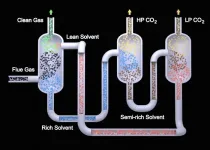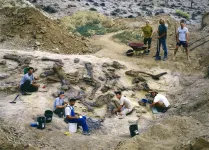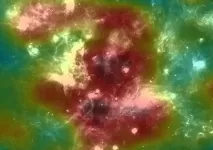(Press-News.org) Irvine, Calif., March 11, 2021 - Catastrophic collapse of materials and structures is the inevitable consequence of a chain reaction of locally confined damage - from solid ceramics that snap after the development of a small crack to metal space trusses that give way after the warping of a single strut.
In a study published this week in Advanced Materials, engineers at the University of California, Irvine and the Georgia Institute of Technology describe the creation of a new class of mechanical metamaterials that delocalize deformations to prevent failure. They did so by turning to tensegrity, a century-old design principle in which isolated rigid bars are integrated into a flexible mesh of tethers to produce very lightweight, self-tensioning truss structures.
Starting with 950 nanometer-diameter members, the team used a sophisticated direct laser writing technique to generate elementary cells sized between 10 and 20 microns. These were built up into eight-unit supercells that could be assembled with others to make a continuous structure. The researchers then conducted computational modeling and laboratory experiments and observed that the constructs exhibited uniquely homogenous deformation behavior free from localized overstress or underuse.
The team showed that the new metamaterials feature a 25-fold enhancement in deformability and an orders-of-magnitude increase in energy absorption over state-of-the-art lattice arrangements.
"Tensegrity structures have been studied for decades, particularly in the context of architectural design, and they have recently been found in a number of biological systems," said senior co-author Lorenzo Valdevit, a UCI professor of materials science and engineering who directs the Architected Materials Group. "Proper periodic tensegrity lattices were theoretically conceptualized only a few years ago by our co-author Julian Rimoli at Georgia Tech, but through this project we have achieved the first physical implementation and performance demonstration of these metamaterials."
While developing structural configurations for planetary landers, the Georgia Tech team discovered that tensegrity-based vehicles could withstand severe deformation, or buckling, of its individual components without collapsing, something never observed in other structures.
"This gave us the idea of creating metamaterials that exploit the same principle, which led us to the discovery of the first-ever 3D tensegrity metamaterial," explained Rimoli, aerospace engineering professor at Georgia Tech.
Made possible by novel additive manufacturing techniques, extremely lightweight yet strong and rigid conventional structures based on micrometer-scale trusses and lattices have been of keen interest to engineers for their potential to replace heavier, solid substances in aircraft, wind turbine blades and a host of other applications. Though possessing many desirable qualities, these advanced materials can - like any load-bearing structure - still be susceptible to catastrophic destruction if overloaded.
"In familiar nano-architected materials, failure usually starts with a highly localized deformation," said first author Jens Bauer, a UCI research scientist in mechanical and aerospace engineering. "Shear bands, surface cracks, and buckling of walls and struts in one area can cause a chain reaction leading to the collapse of an entire structure."
He explained that truss lattices begin to collapse when compressive members buckle, since those in tension cannot. Typically, these parts are interconnected at common nodes, meaning that once one fails, damage can quickly spread throughout the entire structure.
In contrast, the compressive members of tensegrity architectures form closed loops, isolated from one another and only connected by tensile members. Therefore, instability of compressive members can only propagate through tensile load paths, which - provided they do not rupture - cannot experience instability. Push down on a tensegrity system and the whole structure compresses uniformly, preventing localized damage that would otherwise cause catastrophic failure.
According to Valdevit, who's also a professor of mechanical and aerospace engineering at UCI, tensegrity metamaterials demonstrate an unprecedented combination of failure resistance, extreme energy absorption, deformability and strength, outperforming all other types of state-of-the-art lightweight architectures.
"This study provides important groundwork for design of superior engineering systems, from reusable impact protection systems to adaptive load-bearing structures," he said.
INFORMATION:
Julie Kraus, a graduate student in the Rimoli laboratory at Georgia Tech, participated in this research, as did Cameron Crook, a UCI graduate student in materials science and engineering. Funding was made available by NASA and the National Science Foundation.
About the University of California, Irvine: Founded in 1965, UCI is the youngest member of the prestigious Association of American Universities and is ranked among the nation's top 10 public universities by U.S. News & World Report. The campus has produced three Nobel laureates and is known for its academic achievement, premier research, innovation and anteater mascot. Led by Chancellor Howard Gillman, UCI has more than 36,000 students and offers 222 degree programs. It's located in one of the world's safest and most economically vibrant communities and is Orange County's second-largest employer, contributing $5 billion annually to the local economy. For more on UCI, visit http://www.uci.edu.
Media access: Radio programs/stations may, for a fee, use an on-campus ISDN line to interview UCI faculty and experts, subject to availability and university approval. For more UCI news, visit news.uci.edu. Additional resources for journalists may be found at communications.uci.edu/for-journalists.
LAWRENCE -- Much like coronavirus, circulating HIV-1 viruses mutate into diverse variants that pose challenges for scientists developing vaccines to protect people from HIV/AIDS.
"AIDS vaccine development has been a decades-long challenge partly because our immune systems have difficulty recognizing all the diverse variants of the rapidly mutating HIV virus, which is the cause of AIDS," said Brandon DeKosky, assistant professor of pharmaceutical chemistry and chemical & petroleum engineering at the University of Kansas.
In the past five years, tremendous progress has been ...
Philadelphia, March 12, 2021 - Researchers from Children's Hospital of Philadelphia (CHOP) have determined what happens at a cellular level as the lung alveolus forms and allows newborns to breathe air. Understanding this process gives researchers a better sense of how to develop therapies and potentially regenerate this critical tissue in the event of injury. The findings were published online today by the journal Science.
The lung develops during both embryonic and postnatal stages, during which lung tissue forms and a variety of cell types perform specific roles. During the transition from embryo to newborn is when the alveolar region of the lung ...
Skoltech researchers were able to show that patterns that can cause neural networks to make mistakes in recognizing images are, in effect, akin to Turing patterns found all over the natural world. In the future, this result can be used to design defenses for pattern recognition systems currently vulnerable to attacks. The paper, available as an arXiv preprint, was presented at the 35th AAAI Conference on Artificial Intelligence (AAAI-21).
Deep neural networks, smart and adept at image recognition and classification as they already are, can still be vulnerable ...
An enzyme called MARK2 has been identified as a key stress-response switch in cells in a study by researchers at Johns Hopkins Bloomberg School of Public Health. Overactivation of this type of stress response is a possible cause of injury to brain cells in neurodegenerative diseases such as Alzheimer's, Parkinson's, and Amyotrophic Lateral Sclerosis. The discovery will make MARK2 a focus of investigation for its possible role in these diseases, and may ultimately be a target for neurodegenerative disease treatments.
In addition to its potential relevance to neurodegenerative diseases, the finding is an advance in understanding basic cell biology.
The paper describing ...
RICHLAND, Wash.--As part of a marathon research effort to lower the cost of carbon capture, chemists have now demonstrated a method to seize carbon dioxide (CO2) that reduces costs by 19 percent compared to current commercial technology. The new technology requires 17 percent less energy to accomplish the same task as its commercial counterparts, surpassing barriers that have kept other forms of carbon capture from widespread industrial use. And it can be easily applied in existing capture systems.
In a study published in the March 2021 edition of International Journal of Greenhouse Gas Control, researchers from the U.S. Department of Energy's Pacific Northwest National Laboratory--along with collaborators from ...
MADISON, Wis. -- Mexican wolves in the American Southwest disappeared more quickly during periods of relaxed legal protections, almost certainly succumbing to poaching, according to new research published Wednesday.
Scientists from the University of Wisconsin-Madison found that Mexican wolves were 121% more likely to disappear -- despite high levels of monitoring through radio collars -- when legal rulings permitted easier lethal and non-lethal removal of the protected wolves between 1998 and 2016. The disappearances were not due to legal removal, the researchers say, but instead were likely caused by poachers hiding evidence of their activities.
The findings suggest that consistently strong protections for endangered predators lead ...
Fossil sites sometimes resemble a living room table on which half a dozen different jigsaw puzzles have been dumped: It is often difficult to say which bone belongs to which animal. Together with colleagues from Switzerland, researchers from the University of Bonn have now presented a method that allows a more certain answer to this question. Their results are published in the journal Palaeontologia Electronica.
Fossilized dinosaur bones are relatively rare. But if any are found, it is often in large quantities. "Many sites contain the remains of dozens of animals," explains Prof. Dr. Martin Sander from the Institute ...
For the first time ever, a Northwestern University-led research team has peered inside a human cell to view a multi-subunit machine responsible for regulating gene expression.
Called the Mediator-bound pre-initiation complex (Med-PIC), the structure is a key player in determining which genes are activated and which are suppressed. Mediator helps position the rest of the complex -- RNA polymerase II and the general transcription factors -- at the beginning of genes that the cell wants to transcribe.
The researchers visualized the complex in high resolution using cryogenic electron microscopy (cryo-EM), ...
Magnetic resonance imaging (MRI) is already widely used in medicine for diagnostic purposes. Hyperpolarized MRI is a more recent development and its research and application potential has yet to be fully explored. Researchers at Johannes Gutenberg University Mainz (JGU) and the Helmholtz Institute Mainz (HIM) have now unveiled a new technique for observing metabolic processes in the body. Their singlet-contrast MRI method employs easily-produced parahydrogen to track biochemical processes in real time. The results of their work have been published in Angewandte ...
At the heart of Cygnus, one of the most beautiful constellations of the summer sky, beats a source of high-energy cosmic ray particles: the Cygnus Cocoon. An international group of scientists at the HAWC observatory has gathered evidence that this vast astronomical structure is the most powerful of our galaxy's natural particle accelerators known of up to now.
This spectacular discovery is the result of the work of scientists from the international High-Altitude Water Cherenkov (HAWC) gamma-ray observatory. Located on the slopes of the Mexican Sierra Negra volcano, the observatory records high-energy particles and photons flowing from the abyss of space. In the sky of the Northern Hemisphere, their brightest source is the region known as the Cygnus Cocoon. At the HAWC, it was established ...





